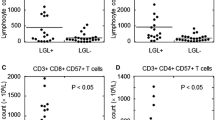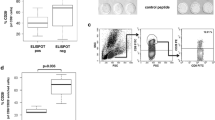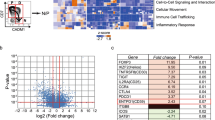Abstract
The Bcr-Abl tyrosine kinase inhibitor imatinib mesylate is highly effective in the front-line treatment of chronic myeloid leukemia (CML) and is increasingly used in patients with residual disease or relapse after allogeneic stem cell transplantation (allo-SCT). Since an impairment of anti-viral CD8+ T-lymphocyte function by imatinib has been described, we question whether imatinib also affects specific anti-leukemic CD8+ T lymphocytes generated from the peripheral blood of healthy donors, and of CML patients after allo-SCT. Here, we assessed CD8+ T-cell expansion and function from healthy donors and patients with CML. The release of IFN-γ and granzyme B by CD8+ T-lymphocytes specific for R3, a recently described T-cell epitope peptide derived from a leukemia-associated antigen designated RHAMM/CD168 (receptor for hyaluronic acid mediated motility), was inhibited by imatinib in a dose-dependent fashion (range: 1–25 μM). These T cells were able to lyse cognate peptide labeled T2 cells and CD34+ CML progenitor cells. This lysis was inhibited by imatinib. The inhibitory effect was not associated with an increased rate of apoptosis of T cells and reversible after removal of imatinib. In the light of these findings, clinical administration of imatinib might result in the reduction of efficacy of the graft-versus-leukemia effect or other T-cell-based immunotherapies.








Similar content being viewed by others
References
Druker BJ, Talpaz M, Resta DJ, Peng B, Buchdunger E, Ford JM, Lydon NB, Kantarjian H, Capdeville R, Ohno-Jones S, Sawyers CL (2001) Efficacy and safety of a specific inhibitor of the BCR-ABL tyrosine kinase in chronic myeloid leukemia. N Engl J Med 344:1031–1037
Savage DG, Antman KH (2002) Imatinib mesylate—a new oral targeted therapy. N Engl J Med 346:683–693
Magnusson MK, Meade KE, Nakamura R, Barrett J, Dunbar CE (2002) Activity of STI571 in chronic myelomonocytic leukemia with a platelet-derived growth factor beta receptor fusion oncogene. Blood 100:1088–1091
Millot F, Guilhot J, Nelken B, Leblanc T, De Bont ES, Bekassy AN, Gadner H, Sufliarska S, Stary J, Gschaidmeier H, Guilhot F, Suttorp M (2006) Imatinib mesylate is effective in children with chronic myelogenous leukemia in late chronic and advanced phase and in relapse after stem cell transplantation. Leukemia 20:187–192
Ramanarayanan J, Dunford LM, Baer MR, Sait SN, Lawrence W, McCarthy PL (2006) Chronic myeloid leukemia after treatment of lymphoid malignancies:Response to imatinib mesylate and favorable outcomes in three patients. Leuk Res 30:701–705
Bornhauser M, Kroger N, Schwerdtfeger R, Schafer-Eckart K, Sayer HG, Scheid C, Stelljes M, Kienast J, Mundhenk P, Fruehauf S, Kiehl MG, Wandt H, Theuser C, Ehninger G, Zander AR (2006) Allogeneic haematopoietic cell transplantation for chronic myelogenous leukemia in the era of imatinib: a retrospective multicentre study. Eur J Haematol 76:9–17
Auffermann-Gretzinger S, Lossos IS, Vayntrub TA, Leong W, Grumet FC, Blume KG, Stockerl-Goldstein KE, Levy R, Shizuru JA (2002) Rapid establishment of dendritic cell chimerism in allogeneic hematopoietic cell transplant recipients. Blood 99:1442–1448
Wassmann B, Pfeifer H, Scheuring U, Klein SA, Gokbuget N, Binckebanck A, Martin H, Gschaidmeier H, Hoelzer D, Ottmann OG (2002) Therapy with imatinib mesylate (Glivec) preceding allogeneic stem cell transplantation (SCT) in relapsed or refractory Philadelphia-positive acute lymphoblastic leukemia (Ph+ALL). Leukemia 16:2358–2365
Kantarjian HM, O’Brien S, Cortes JE, Giralt SA, Rios MB, Shan J, Giles FJ, Thomas DA, Faderl S, De Lima M, Garcia-Manero G, Champlin R, Arlinghaus R, Talpaz M (2002) Imatinib mesylate therapy for relapse after allogeneic stem cell transplantation for chronic myelogenous leukemia. Blood 100:1590–1595
Olavarria E, Craddock C, Dazzi F, Marin D, Marktel S, Apperley JF, Goldman JM (2002) Imatinib mesylate (STI571) in the treatment of relapse of chronic myeloid leukemia after allogeneic stem cell transplantation. Blood 99:3861–3862
Wassmann B, Scheuring U, Thiede C, Pfeifer H, Bornhauser M, Griesinger F, Hochhaus A, Schleyer E, Gschaidmeier H, Hoelzer D, Ottmann OG (2003) Stable molecular remission induced by imatinib mesylate (STI571) in a patient with CML lymphoid blast crisis relapsing after allogeneic stem cell transplantation. Bone Marrow Transplant 31:611–614
Demetri GD, von Mehren M, Blanke CD, Van den Abbeele AD, Eisenberg B, Roberts PJ, Heinrich MC, Tuveson DA, Singer S, Janicek M, Fletcher JA, Silverman SG, Silberman SL, Capdeville R, Kiese B, Peng B, Dimitrijevic S, Druker BJ, Corless C, Fletcher CD, Joensuu H (2002) Efficacy and safety of imatinib mesylate in advanced gastrointestinal stromal tumors. N Engl J Med 347:472–480
Robert S Benjamin, Charles D Blanke, Jean-Yves Blay, Sylvie Bonvalot, Burton Eisenberg (2006) Management of Gastrointestinal Stromal Tumors in the Imatinib Era: Selected Case Studies. The Oncologist 11:9–20
Efron DT, Lillemoe KD (2005) The current management of gastrointestinal stromal tumors. Adv Surg 39:193–221
Cesare Guglielmi, William Arcese, Francesco Dazzi, Ronald Brand, Donald Bunjes, Leo F. Verdonck, Anton Schattenberg, Hans-Jochem Kolb, Per Ljungman, Agnes Devergie, Andrea Bacigalupo, Marta Gomez, Mauricette Michallet, Ahmet Elmaagacli, Alois Gratwohl, Jane Apperley, Dietger Niederwieser on behalf of the Chronic Leukemia Working Party of the European Group for Blood and Marrow Transplantation (2002) Donor lymphocyte infusion for relapsed chronic myelogenous leukemia: prognostic relevance of the initial cell dose. Blood 100:397–405
DeAngelo DJ, Hochberg EP, Alyea EP, Longtine J, Lee S, Galinsky I, Parekkedon B, Ritz J, Antin JH, Stone RM, Soiffer RJ (2004) Extended follow-up of patients treated with imatinib mesylate (gleevec) for chronic myelogenous leukemia relapse after allogeneic transplantation: durable cytogenetic remission and conversion to complete donor chimerism without graft-versus-host disease. Clin Cancer Res 10:5065–5071
Peng B, Hayes M, Resta D, Racine-Poon A, Druker BJ, Talpaz M, Sawyers CL, Rosamilia M, Ford J, Lloyd P, Capdeville R (2004) Pharmacokinetics and pharmacodynamics of imatinib in a phase I trial with chronic myeloid leukemia patients. J Clin Oncol 22:935–942
Druker BJ, Lydon NB (2000) Lessons learned from the development of an abl tyrosine kinase inhibitor for chronic myelogenous leukemia. J Clin Invest 105:3–7
Druker BJ, Tamura S, Buchdunger E, Ohno S, Segal GM, Fanning S, Zimmermann J, Lydon NB (1996) Effects of a selective inhibitor of the Abl tyrosine kinase on the growth of Bcr-Abl positive cells. Nat Med 2:561–566
Deininger MW, Goldman JM, Lydon N, Melo JV (1997) The tyrosine kinase inhibitor CGP57148B selectively inhibits the growth of BCR-ABL-positive cells. Blood 90:3691–3698
Gambacorti-Passerini C, le Coutre P, Mologni L, Fanelli M, Bertazzoli C, Marchesi E, Di Nicola M, Biondi A, Corneo GM, Belotti D, Pogliani E, Lydon NB (1997) Inhibition of the ABL kinase activity blocks the proliferation of BCR/ABL+ leukemic cells and induces apoptosis. Blood Cells Mol Dis 23:380–394
Buchdunger E, Cioffi CL, Law N, Stover D, Ohno-Jones S, Druker BJ, Lydon NB (2000) Abl protein-tyrosine kinase inhibitor STI571 inhibits in vitro signal transduction mediated by c-kit and platelet-derived growth factor receptors. J Pharmacol Exp Ther 295:139–145
Heinrich MC, Griffith DJ, Druker BJ, Wait CL, Ott KA, Zigler AJ (2000) Inhibition of c-kit receptor tyrosine kinase activity by STI 571, a selective tyrosine kinase inhibitor. Blood 96:925–932
Okuda K, Weisberg E, Gilliland DG, Griffin JD (2001) ARG tyrosine kinase activity is inhibited by STI571. Blood 97:2440–2448
Carroll M, Ohno-Jones S, Tamura S, Buchdunger E, Zimmermann J, Lydon NB, Gilliland DG, Druker BJ (1997) CGP 57148, a tyrosine kinase inhibitor, inhibits the growth of cells expressing BCR-ABL, TEL-ABL, and TEL-PDGFR fusion proteins. Blood 90:4947–4952
Seggewiss R, Lore K, Greiner E, Magnusson MK, Price DA, Douek DC, Dunbar CE, Wiestner A (2005) Imatinib inhibits T-cell receptor-mediated T-cell proliferation and activation in a dose-dependent manner. Blood 105:2473–2479
Appel S, Balabanov S, Brummendorf TH, Brossart P (2005) Effects of imatinib on normal hematopoiesis and immune activation. Stem Cells 23:1082–1088
Dietz A, Souan L, Knutson G, Bulur P, Litzow M, Vuk-Pavlovic S (2004) Imatinib mesylate inhibits T-cell proliferation in vitro and delayed-type hypersensitivity in vivo. Blood 104:1094–1099
Gao H, Lee BN, Talpaz M, Donato NJ, Cortes JE, Kantarjian HM, Reuben JM (2005) Imatinib mesylate suppresses cytokine synthesis by activated CD4 T cells of patients with chronic myelogenous leukemia. Leukemia 19:1905–1911
Appel S, Rupf A, Weck MM, Schoor O, Brummendorf TH, Weinschenk T, Grunebach F, Brossart P (2005) Effects of imatinib on monocyte-derived dendritic cells are mediated by inhibition of nuclear factor-kappaB and Akt signaling pathways. Clin Cancer Res11:1928–1940
Wang H, Cheng F, Cuenca A, Horna P, Zheng Z, Bhalla K, Sotomayor EM (2004) Imatinib mesylate (STI-571) enhances antigen-presenting cell function and overcomes tumor-induced CD4+ T-cell tolerance. Blood 105:1135–1143
Savani BN, Montero A, Kurlander R, Childs R, Hensel N, Barrett AJ (2005) Imatinib synergizes with donor lymphocyte infusions to achieve rapid molecular remission of CML relapsing after allogeneic stem cell transplantation. Bone Marrow Transplant 36:1009–1015
Chunduri S, Dobogai LC, Bruno A, Kadkol S, Rondelli D (2005) Does post-transplant treatment with imatinib mesylate inhibit graft-versus-leukemia? Leukemia 9:456–457
Weisser M, Tischer J, Schnittger S, Schoch C, Ledderose G, Kolb HJ (2006) A comparison of donor lymphocyte infusions or imatinib mesylate for patients with chronic myelogenous leukemia who have relapsed after allogeneic stem cell transplantation. Haematologica 9:663–666
Greiner J, Li L, Ringhoffer M, Barth T, Giannopoulos K, Guillaume P, Ritter G, Wiesneth M, Dohner H, Schmitt M (2005) Identification and characterization of epitopes of the receptor for hyaluronic acid-mediated motility (RHAMM/CD168) recognizied by CD8+ T cells of HLA-A2-positive patients with acute myeloid leukemia. Blood 106:938–945
Li L, Reinhardt P, Schmitt A, Barth TF, Greiner J, Ringhoffer M, Dohner H, Wiesneth M, Schmitt M (2005) Dendritic cells generated from acute myeloid leukemia (AML) maintain the expression of immunogenic leukemia associated antigens. Cancer Immunol Immunother 54:685–693
Schmitt M, Schmitt A, Reinhardt P, Thess B, Manfras B, Lindhofer H, Riechelmann H, Wiesneth M, Gronau S (2004) Opsonization with a trifunctional bispecific (alphaCD3 x alphaEpCAM) antibody results in efficient lysis in vitro and in vivo of EpCAM positive tumor cells by cytotoxic T lymphocytes. Int J Oncol 25:841–848
Molldrem J, Lee PP, Wang C, Champlin RE, Davis MM (1999) A PR1-human leukocyte antigen-A2 tetramer can be used to isolate low-frequency cytotoxic T lymphocytes from healthy donors that selectively lyse chronic myeloid leukemia. Cancer Res 59:2675–2681
Greiner J, Ringhoffer M, Taniguchi M, Schmitt A, Kirchner D, Krachn G, Heilmann V, Gschwend J, Bergmann L, Dohner H, Schmitt M (2002) Receptor for hyaluronan acid-mediated motility (RHAMM) is a new immunogenic leukemia-associated antigen in acute and chronic myeloid leukemia. Exp Hematol 30:1029–1035
Greiner J, Ringhoffer M, Taniguchi M, Hauser T, Schmitt A, Dohner H, Schmitt M (2003) Characterization of several leukemia-associated antigens inducing humoral immune responses in acute and chronic myeloid leukemia. Int J Cancer 106:224–231
Mailander M, Scheibenbogen C, Thiel E, Letsch A, Blau IW, Keilholz U (2004) Complete remission in a patient with recurrent acute myeloid leukemia induced by vaccination with WT1 peptide in the absence of hematological or renal toxicity. Leukemia 18:165–166
Molldrem J, Kant S, Lu S (2002) peptide vaccination with PR1 elicits active T cell immunity that induces cytogenetic remission in acute myelogenous leukemia. Blood 98 abstract 8:92
Oka Y, Udaka k, Tsuboi A, Elisseeva OA, Ogawa H, Aozasa K, Kishhimoto T, Sugiyama H (2000) Cancer immunotherapy targeting Wilms’tumor gene WT1 product. J Immunol 164:1873–1880
Ohminami H, Yasukawa M, Fujita S (2000) HLA class I-restricted lysis of leukemia cells by a CD8+ cytotoxic T-lymphocyte clone specific fir WT1 peptide. Blood 95:286–293
Maziarz RT (2004) Imatinib mesylate: a novel immune suppressive agent? Blood 104:914–915
Perez-Abad M, Perez-Oteyza J, Arranz Pena MI, Lopez Jimenez J, Larana JG, Sevillano RP (2006) Monitoring serum levels of imatinib and hematological toxicity in CML patients. Haematologica 91(s1):60
Piazza RG, Magistroni V, Andreoni F, Franceschino A, Tornaghi L, Varella-Garcia M, Bungaro S, Colnaghi F, Corneo G, Pogliani EM, Gambacorti-Passerini C (2005) Imatinib dose increase up to 1200 mg daily can induce new durable complete cytogenetic remissions in relapsed Ph+ chronic myeloid leukemia patients. Leukemia 19:1985–1987
Peng B, Lloyd P, Schran H (2005) Clinical pharmacokinetics of imatinib. Clin Pharmacokinet 44:879–894
Acknowledgment
We thank Ms Goetz for her excellent technical support in this project. This research was kindly supported by Novartis, Nuremberg, Germany.
Author information
Authors and Affiliations
Corresponding author
Rights and permissions
About this article
Cite this article
Chen, J., Schmitt, A., Chen, B. et al. Imatinib impairs CD8+ T lymphocytes specifically directed against the leukemia-associated antigen RHAMM/CD168 in vitro. Cancer Immunol Immunother 56, 849–861 (2007). https://doi.org/10.1007/s00262-006-0232-9
Received:
Accepted:
Published:
Issue Date:
DOI: https://doi.org/10.1007/s00262-006-0232-9




